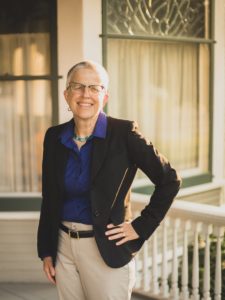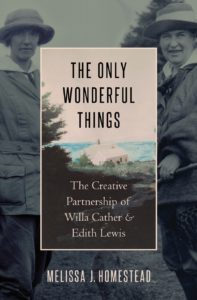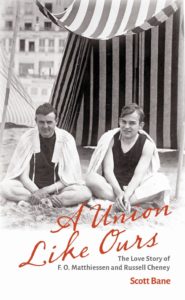What is the relationship between artistic vocation and sexual identity? Between creative and romantic partnerships? And how should we assess forms of same-sex union and choices about queer self-representation from an era in which options were fewer (and risks greater) than they are today?

Two recent biographies explore these interrelated questions. Melissa J. Homestead’s The Only Wonderful Things: The Creative Partnership of Willa Cather and Edith Lewis and Scott Bane’s A Union Like Ours: The Love Story of F.O. Matthiessen and Russell Cheney examine the lives of two prominent figures in the American literary landscape in the first half of the 20th century. The two authors will discuss their books at this year’s Provincetown Book Festival on Saturday, Sept. 17.
While Willa Cather, one of America’s first critically acclaimed women writers, and the scholar F.O. Matthiessen, a principal founder of American studies as an academic discipline, led very different lives, the biographies draw many similarities between them. Both maintained lifelong same-sex unions with partners who were creatives in their own right and who afforded them resources — both personal and professional — that were pivotal to their success. In both relationships, the elder partner died early in the Cold War, amidst rising anti-Communist and homophobic hysteria that constrained the survivor’s public memorialization of the relationship and grief. In recounting and celebrating these unions, Homestead and Bane spotlight the historically overshadowed partner of a more famous figure and argue, in different ways, for their unrecognized centrality.

In Homestead’s book, Cather’s partner Edith Lewis emerges as a fascinating figure: intellectually sophisticated, professionally accomplished, and socially skilled (if personally shy and even self-effacing). An artistically precocious youth and graduate of Smith College, Lewis preceded Cather — her older fellow Nebraskan — to New York, where both found work on magazine editorial staffs while also publishing stories of their own. Early in their life together, Cather quit editorial work to write full-time while Lewis — then the couple’s principal breadwinner — rose through the ranks, becoming literary editor of the magazine Every Week and later lead female copywriter for the country’s largest advertising agency, with sole responsibility for two million-dollar accounts.
Described by a co-worker as “the best boss I ever had, the most intelligent, the most just, the kindest, and the bluntest,” Lewis brought those qualities to her editing of Cather’s most celebrated novels. Indeed, Homestead argues, the novelist’s signature compressed style “was the product of the collaboration with an advertising copywriter who practiced her tradecraft of ‘drastic revision’ and ‘condensation’ on Cather’s fiction.” Of course, in keeping with editorial and copywriting convention, Lewis’s name does not appear on Cather’s work.
Close friends and family members understood and accepted their intimacy, but the women’s discretion allowed an opportunistic and heterosexist Cather biographer to “ghost” both her sexuality and Lewis’s substantial and creative presence in her partner’s life and work after Cather’s death. (That discretion extended to their personal correspondence: although one extant letter from Cather to Lewis begins with “My darling Edith,” and signs off “Lovingly, W,” it is mainly a sexually suggestive description of the annual planetary conjunction of Jupiter and Venus; neither it nor any of either woman’s surviving letters directly identifies their relationship as lesbian.) In documenting Cather’s and Lewis’s intersecting careers and shared life, Homestead aims to redress both erasures.

In contrast to Cather and Lewis, Matthiessen and Cheney exchanged some 3,000 overtly romantic and often sexually explicit letters and journal entries, a selection of which was published more than 40 years ago. Consequently, both Matthiessen’s sexuality and the importance of his relationship with Cheney have long been acknowledged in scholarship on his work and life. Bane touches on the painter Cheney’s intellectual and artistic contributions to the critical scope and sensibility that enabled Matthiessen to produce his field-defining book, American Renaissance. (Cheney introduced his lover to Walt Whitman, enhanced his knowledge of visual culture, and strengthened his appreciation of landscape — all important elements of Matthiessen’s synthetic analysis of American cultural expression.)
But as the book’s subtitle says, Bane’s interest lies not in his subjects’ creative partnership but in their love story, which he sees as an “uncanny” forerunner of his own. A Union Like Ours is framed by an autobiographical prologue and epilogue that map some geographical and circumstantial coincidences linking Bane’s life and union with his husband to the lives and union of Matthiessen and Cheney — coincidences that made Bane feel like he communicated with his subjects “in a way that transcended time” and that they had somehow chosen him as their biographer.

Bane’s personal identification with the union lends his book emotional intensity. But it also produces a bias, manifest in his largely censorious treatment of the more publicly cautious Matthiessen and his reluctance to acknowledge the manipulative and destructive elements that the more daring and open Cheney brought to their relationship.
Born into and supported by old family wealth, Cheney cultivated a talent for painting, a “zest for life,” a “penchant for tough, thug-like boxers,” and drunken binges with strangers. His chance 1924 meeting with Matthiessen, 20 years his junior, offered both men “a different world in which love and sex could come together.” Cheney, Bane writes, was “the emotional center” of that world, and “it was Cheney who made [their house, in Kittery, Maine] a home.”
But it was also Cheney who — despite Matthiessen’s interventions, and at the height of Matthiessen’s career — sacrificed that home through frequent alcoholic episodes, sanitarium visits, and finally residence with his sister in Texas. Bane characterizes Cheney’s drinking as “part of his broader sensuality” and faults Matthiessen for effectively choosing fidelity to his intellectual and professional life over fidelity to his body and emotions: Matthiessen, he writes, was unwilling to “step off the ladder of professional ambition” and unable to “imagine a world in which a person’s sexuality could be part of his or her public identity.” For Bane, his own proudly public and enduring union and others like it honor — and, in a way, redeem — Cheney’s and Matthiessen’s loving yet fraught and semi-closeted one.
Homestead might well agree. Yet for her, time is not quite so readily transcended. While she also identifies as lesbian, she is less inclined to judge her historical subjects’ life choices or queer authenticity. Lewis and Cather lived, she writes, “in one of the many ways that women in same-sex relationships in the early twentieth century might have lived.” In the end, how they managed “to combine sharing, love, and intimacy with autonomy and a devotion to their own careers” was what mattered.
It Takes Two
The event: Scott Bane and Melissa Homestead talk about biography at the Provincetown Book Festival
The time: Saturday, Sept. 17, 11:30 a.m.
The place: Provincetown Public Library, 356 Commercial St.
The cost: Free
